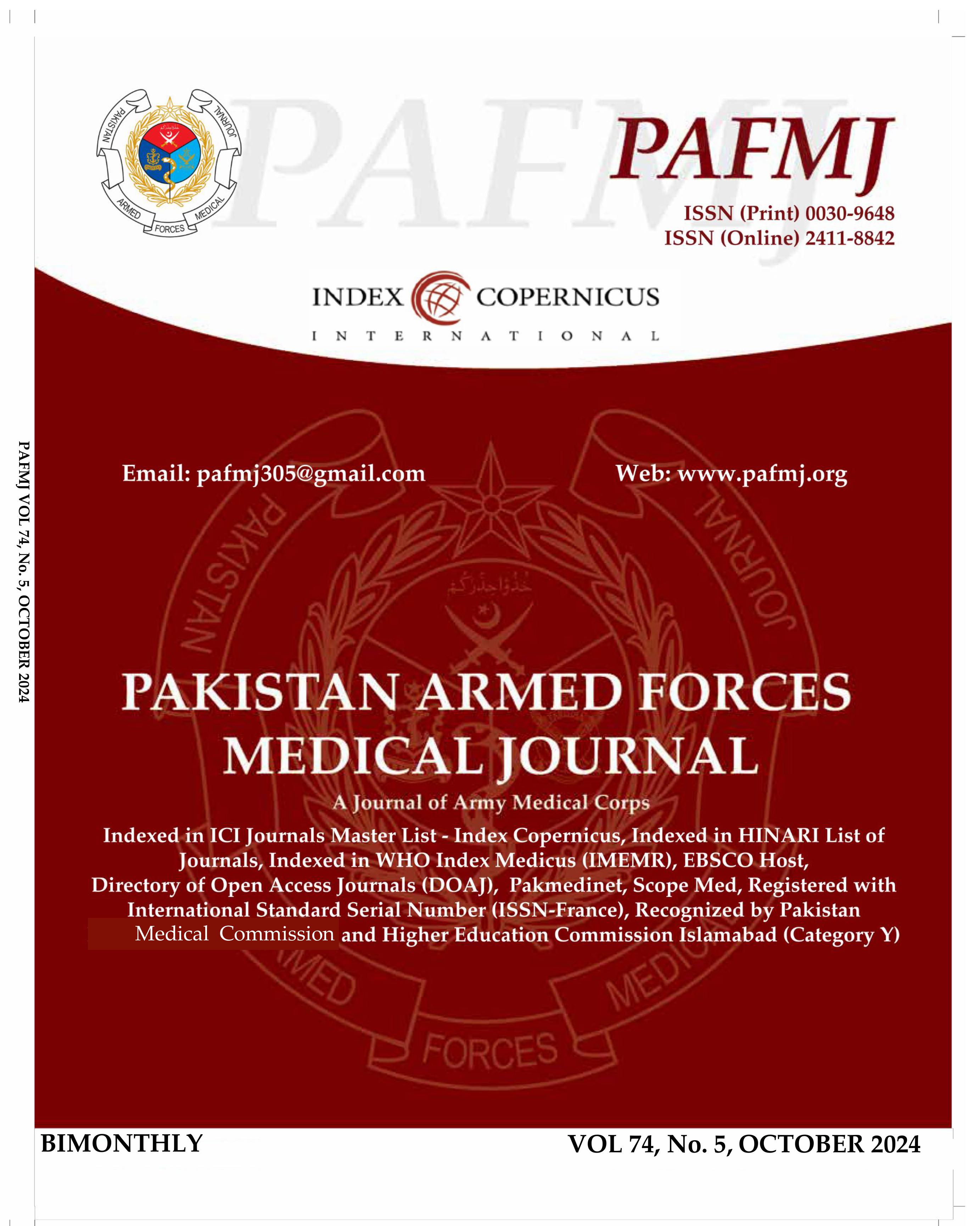Metabolic Syndrome Severity Score in Subjects with and without Poly Cystic Ovarian Syndrome
DOI:
https://doi.org/10.51253/pafmj.v74i5.8626Keywords:
Homeostasis Model Assessment of insulin resistance (HOMA-IR), Metabolic Syndrome Severity Score (MSSS), Modified Ferriman Gallway Scoring (mFG score), Polycystic ovarian syndrome (PCOS), Rotterdam PCOS criteria.Abstract
Objective: To compare polycystic ovarian syndrome and their defining criteria with metabolic syndrome severity score among females with and without polycystic ovarian syndrome.
Study Design: Comparative cross-sectional study.
Place and Duration of Study: Naval Hospital Islamabad, from Jan 2018 to Dec 2021.
Methodology: We evaluated 293 female subjects for Poly Cystic Ovarian Syndrome after several exclusions who presented with an initial complaint of disturbances in menstrual cycles. These subjects underwent clinical examination including blood pressure and anthropometric indices and measurements of modified Ferriman Gallway score. Biochemical measurements included fasting plasma glucose, HDL cholesterol, triglycerides and insulin measurement. These parameters were measured for various components included in defining the Poly Cystic Ovarian Syndrome as per Rotterdam criteria and Metabolic Syndrome Severity Score equation to compare metabolic syndrome severity and insulin resistance among subjects with Poly Cystic Ovarian Syndrome and without Poly Cystic Ovarian Syndrome.
Results: Mean age among participants were 29.46±6.74 years. Disturbances in menstrual cycle reporting oligo/anovulation was reported by (181/293) 61.8% in comparison to (112/293) 38.2%. Hirsutism (modified Ferriman Gallway score>8) was present in (142/293) 48.5%. Radiological findings pointing towards Poly Cystic Ovarian Syndrome diagnosis were found in (72/293) 24.6%. Metabolic Syndrome Severity Score showed higher correlation with age, and insulin resistance in contrast to hirsutism and free androgen indices. Hirsutism was higher among oligo/anovulation females than participants without menstrual complaints (14.17+8.99 vs. 11.16+7.88, p=0.004). Similarly, bioc
Conclusion: Metabolic Syndrome Severity Score equation does not associate with Poly Cystic Ovarian Syndrome criteria as defined by Rotterdam. Insulin resi
Downloads
References
Azziz R. Polycystic Ovary Syndrome. Obstet Gynecol 2018; 132(2): 321-336.
https://doi.org/10.1097/AOG.0000000000002698
Sekhon AK, Zergham AS, Tserenpil G, Mebasher A, Malik BH. The Association between Polycystic Ovary Syndrome and Its Dermatological Manifestations. Cureus 2020; 12(2): e6855.
https://doi.org/10.7759/cureus.6855
Chamberlain G, Wood C. Stein-Leventhal Syndrome. Br Med J 1964 ;1(5375): 96-98. https://doi.org/ 10.1136/bmj.1.5375.96
Rasquin Leon LI, Anastasopoulou C, Mayrin JV. Polycystic Ovarian Disease. 2021. In: StatPearls. Treasure Island (FL): StatPearls Publishing; 2022.
Wang J, Wu D, Guo H, Li M. Hyperandrogenemia and insulin resistance: The chief culprit of polycystic ovary syndrome. Life Sci 2019; 236: 116940. https://doi.org/10.1016/j.lfs.2019.116940
Nolan CJ, Prentki M. Insulin resistance and insulin hypersecretion in the metabolic syndrome and type 2 diabetes: Time for a conceptual framework shift. Diab Vasc Dis Res 2019; 16(2): 118-127. https://doi.org/10.1177/1479164119827611
Moghetti P, Tosi F. Insulin resistance and PCOS: chicken or egg? J Endocrinol Invest 2021; 44(2): 233-244.
https://doi.org/10.1007/s40618-020-01351-0
Jeanes YM, Reeves S. Metabolic consequences of obesity and insulin resistance in polycystic ovary syndrome: diagnostic and methodological challenges. Nutr Res Rev 2017; 30(1):97-105. https://doi.org/10.1017/S0954422416000287
Bruni V, Capozzi A, Lello S. The Role of Genetics, Epigenetics and Lifestyle in Polycystic Ovary Syndrome Development: the State of the Art. Reprod Sci 2022; 29(3): 668-679. https://doi.org/10.1007/s43032-021-00515-4
Jeanes YM, Reeves S. Metabolic consequences of obesity and insulin resistance in polycystic ovary syndrome: diagnostic and methodological challenges. Nutr Res Rev 2017; 30(1): 97-105. https://doi.org/ 10.1017/S0954422416000287
Park PG, Pyo JY, Ahn SS, Song JJ, Park YB, Huh JH, et al. Metabolic Syndrome Severity Score, Comparable to Serum Creatinine, Could Predict the Occurrence of End-Stage Kidney Disease in Patients with Antineutrophil Cytoplasmic Antibody-Associated Vasculitis. J Clin Med 2021; 10(24): 5744. https://doi.org/ 10.3390/jcm10245744
Aswini R, Jayapalan S. Modified Ferriman-Gallwey Score in Hirsutism and its Association with Metabolic Syndrome. Int J Trichology 2017; 9(1): 7-13. https://doi.org/ 10.4103/ijt.ijt_93_16
Li W, Chen Q, Xie Y, Hu J, Yang S, Lin M. Prevalence and degree of insulin resistance in Chinese Han women with PCOS: Results from euglycemic-hyperinsulinemic clamps. Clin Endocrinol 2019; 90(1): 138-144. https://doi.org/10.1111/cen.13860
Rotterdam ESHRE/ASRM-Sponsored PCOS Consensus Workshop Group. Revised 2003 consensus on diagnostic criteria and long-term health risks related to polycystic ovary syndrome. Fertil Steril 2004; 81(1): 19-25.
Ali AT. Polycystic ovary syndrome and metabolic syndrome. Ceska Gynekol 2015; 80(4): 279-289.
Asato CBH, Nelson-Hurwitz DC, Lee T, Grandinetti A. Comparative Analysis of Metabolic Syndrome Diagnostic Criteria and Its Effects on Prevalence in a Multiethnic Population. Metab Syndr Relat Disord 2021 ;19(6):347-351. https://doi.org/10.1089/met.2020.0090
Lim SS, Kakoly NS, Tan JWJ, Fitzgerald G, Bahri Khomami M, Joham AE, et al. Metabolic syndrome in polycystic ovary syndrome: a systematic review, meta-analysis and meta-regression. Obes Rev 2019; 20(2): 339-352.
https://doi.org/10.1111/obr.12762
Jamil AS, Alalaf SK, Al-Tawil NG, Al-Shawaf T. A case-control observational study of insulin resistance and metabolic syndrome among the four phenotypes of polycystic ovary syndrome based on Rotterdam criteria. Reprod Health 2015 ;12: 7. https://doi.org/110.1186/1742-4755-12-7
Bil E, Dilbaz B, Cirik DA, Ozelci R, Ozkaya E, Dilbaz S. Metabolic syndrome and metabolic risk profile according to polycystic ovary syndrome phenotype. J Obstet Gynaecol Res 2016; 42(7): 837-843. https://doi.org/10.1111/jog.12985
Mimouni NEH, Paiva I, Barbotin AL, Timzoura FE, Plassard D, Le Gras S, et al. Polycystic ovary syndrome is transmitted via a transgenerational epigenetic process. Cell Metab 2021; 33(3): 513-530.e8. https://doi.org/10.1016/j.cmet.2021.01.004
Wawrzkiewicz-Jałowiecka A, Kowalczyk K, Trybek P, Jarosz T, Radosz P, Setlak M, et al. In Search of New Therapeutics-Molecular Aspects of the PCOS Pathophysiology: Genetics, Hormones, Metabolism and Beyond. Int J Mol Sci 2020 ;21(19):7054. https://doi.org/10.3390/ijms21197054
Toosy S, Sodi R, Pappachan JM. Lean polycystic ovary syndrome (PCOS): an evidence-based practical approach. J Diabetes Metab Disord 2018; 17(2):277-285.
https://doi.org/10.1007/s40200-018-0371-5
Stovall DW, Bailey AP, Pastore LM. Assessment of insulin resistance and impaired glucose tolerance in lean women with polycystic ovary syndrome. J Womens Health 2011 ;20(1):37-43. https://doi.org/10.1089/jwh.2010.2053
Downloads
Published
Issue
Section
License
Copyright (c) 2024 Sikandar Hayat Hhan, Ayesha Hafeez, Rahat Shahid, Muhammad Qamar Ul Haq Noor, Javeria Hafeez, Mehreen Gillani

This work is licensed under a Creative Commons Attribution-NonCommercial 4.0 International License.















